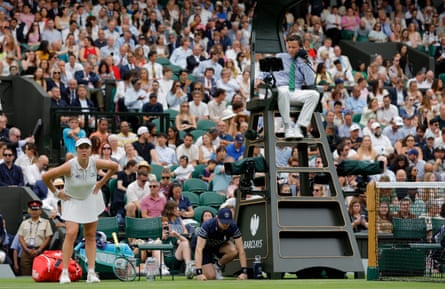We are all suckers for a good story. And there was certainly a cracking two‑parter at Wimbledon this year. First came the news that 300 line judges had been replaced by artificial intelligence robots. Then, a few days later, it turned out there were some embarrassing gremlins in the machine. Not since Roger Federer hung up his Wilson racket has there been a sweeter spot hit during the Wimbledon fortnight.
First the new electronic line-judging system failed to spot that Sonay Kartal had whacked a ball long during her match against Anastasia Pavlyuchenkova – which led to the Russian losing a game she otherwise would have won. Although, ironically, it happened only because an official had accidentally switched the system off.
Then a Taylor Fritz forehand was called out despite landing four feet inside the baseline. This time the system had been confused by a ballboy still being on court when the American began his serve.
In truth, it was far less serious than in the Kartal one. But it didn’t matter. The narrative was established. Technology was robbing us of our jobs, stealing our cherished traditions. And the twist? It also suggested that computers couldn’t replace human judgment after all.
Rather lost in all the outrage was the fact that Wimbledon was actually using a souped-up version of the same Hawk-Eye system that it has employed since 2007. And a couple of incidents, albeit embarrassing ones, should not make us ignore the broader reality. Technology is far better than the human eye. It makes far fewer errors. And it’s not even close.
Long ago, researchers estimated that line judges get around 8% of close calls wrong. But, if anything, players’ judgments are far worse.
When I asked IBM how often players got it right when they challenged a line call at Wimbledon last year, I expected it to be about 50/50. But of the 1,535 challenges across the men’s and women’s singles in 2024 just 380 – less than 25% – were overturned. In other words, when a player thought the ball was out and made a challenge, they were wrong three out of four times.
And there is a wider point, which a Wimbledon official stressed to me about the use of technology in sport: sporting bodies are using it not only because players, by and large, want it, but because it protects the integrity of sport and officials too. Gone are the days when a decision went against supporters or gamblers and they shrugged their shoulders. Nowadays they abuse players and officials on social media and mutter about dark conspiracies.
At the last Rugby World Cup, Wayne Barnes even spoke of receiving “threats of sexual violence to my wife, threats of violence against my children – and you’re like, is that really what sport is about?” He is far from alone. In such a fevered environment, anything that helps an official has to be a good thing.

And even when referees do their best, they are unconsciously influenced by crowds. One study asked 40 qualified football referees to judge 47 incidents from a match between Liverpool and Leicester; half watched with crowd noise, the control group in silence. Those viewing the footage with crowd noise awarded significantly fewer fouls (15.5%) against Liverpool compared with those watching in silence.
Another study in Norway found that successful teams were more likely to be given favourable penalty decisions. Psychologists call this influence conformity. And say what you like about machines, they are immune to that, too.
Critics of technology in sport are often deeply resistant to change. They also demand perfection. But to quote Voltaire, perfect is the enemy of good. Instead, we should be asking, is the tech better and more accurate than what was in place before – and is there scope for further improvement?
after newsletter promotion
Hawk-Eye is more accurate now than it was when it was introduced in 2007. It will continue to get better. And while there are plenty of critics of VAR, the way Fifa has used it at the World Cup and Club World Cup – with fewer delays and letting fans see the replays the officials watch – shows it can work. Let’s hope the Premier League was taking notes.
One thing is clear, though. More is to come. That’s according to Matt Drew, who founded the integrity department at StatsPerform, a leading data and sports integrity provider.
“No system is 100% perfect, but they are demonstrably more accurate than relying purely on human decision-making,” he says. “Sports believe that technology helps them get more decisions right and protects officials and players from abuse. The best ones – like in tennis and cricket – also balance it in a way that preserves the fan experience. And they are going to continue to use and refine it, so it becomes more accurate.”
What might we see? Well, at the International Olympic Committee’s artificial intelligence conference last year it showed a diver in real time, with a screen immediately telling a judge the height of his jump, the number of rotations in the air and how close his legs were to his torso as he spun. Each element of the dive was also split into sequences, with everything analysed in less than a tenth of a second. The idea was to give every judge a far better idea of the quality of the dive and be able to award a fairer score. Who would be against that?
Meanwhile as the machines continue their rise, more traditions will inevitably slip away. From September, for instance, the NFL will replace its “chain gang” of officials who walk on to the pitch to mark first downs with Hawk-Eye technology. In truth, I will miss them. But having someone guess where the ball should be placed feels far closer to the 18th century than the 21st.
Do you have an opinion on the issues raised in this article? If you would like to submit a response of up to 300 words by email to be considered for publication in our letters section, please click here.

 3 months ago
45
3 months ago
45

















































